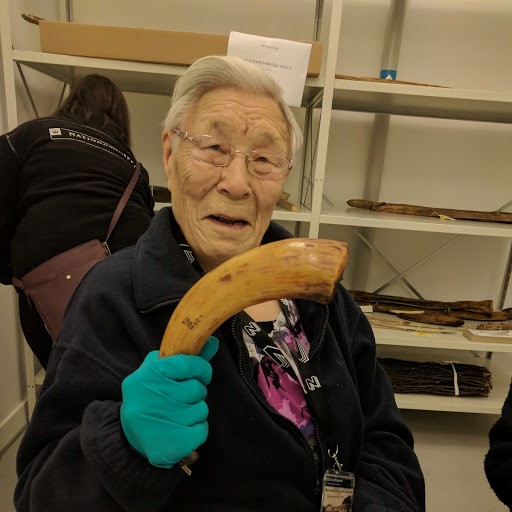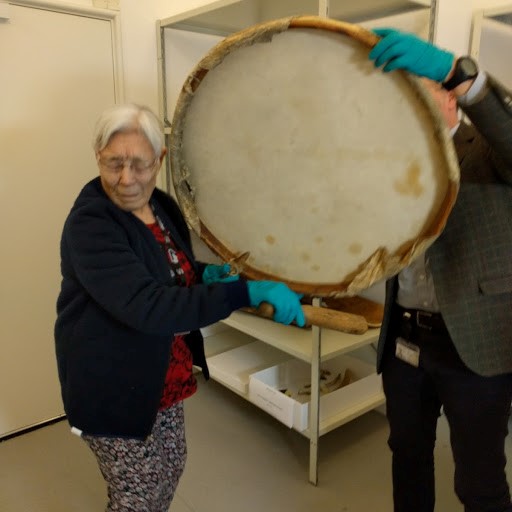The Kitikmeot Heritage Society is a unique Inuit research organization with twenty years’ experience preserving and communicating Inuit knowledge, and ten years’ experience realizing its mandate through online technologies such as the pilot Fifth Thule Expedition Atlas, a project that was developed in part through a grant from CIRA’s Community Investment Program in 2014. Initiated by the Inuit community and with the support of the Kitikmeot Heritage Society, there has been an ongoing effort to bring their history back home.
The Kitikmeot Heritage Society is a unique Inuit research organization with twenty years’ experience preserving and communicating Inuit knowledge, and ten years’ experience realizing its mandate through online technologies such as the pilot Fifth Thule Expedition Atlas, a project that was developed in part through a grant from CIRA’s Community Investment Program in 2014.
Initiated by the Inuit community and with the support of the Kitikmeot Heritage Society, there has been an ongoing effort to bring their history back home. But the drive to revitalize Inuit culture in Nunavut is being challenged again and again. Cultural material is owned by institutions in distant countries, making it difficult to access, and Inuit Elders, who hold first-hand knowledge of land-based lifestyles, are passing on. The Kitikmeot Heritage Society is doing their part to address these issues by using the internet to capture Inuit history and connect people through a past that would otherwise be lost.
The Fifth Thule Expedition
From 1921 to 1924, Knud Rasmussen, a Danish Inuktitut-speaking anthropologist, led the Fifth Thule Expedition – an expedition that would complete the first comprehensive recording of traditional Inuit societies in Canada. As Rasmussen’s team travelled across the north, they collected vast amounts of oral traditions, traditional place names, linguistic information, Inuit drawn maps, photographs, and over 2000 ethnographic objects. While some of this knowledge has been published, the majority remains inaccessible to the public, being stored in Danish archives and museum collections.
In December 2017, Darren Keith and Pamela Gross from the Kitikmeot Heritage Society had the unique opportunity to travel to Denmark with two Inuit Elders to explore the archives and ethnographic collection stored at the National Museum of Denmark. As part of the Atlas project, the purpose of the journey was to bring this knowledge back to Inuit people by collecting names and descriptions of the various objects.
The Fifth Thule Expedition Atlas is a digital platform that compiles the ethnographic information collected by Rasmussen and his team in hopes of making this invaluable Inuit knowledge accessible to the wider public – including Inuit whose ancestors were initially visited by the expedition. In 2016, the Kitikmeot Heritage Society received another Community Investment Program grant to advance their project. This time their goal was to digitize materials at the National Museum of Denmark, continue to populate the Atlas, and visit stakeholder communities to give Inuit the opportunity to guide the development of the Atlas. Their recent trip to Denmark was only a small piece of the larger project, but an invaluable experience all around.
The Elders had the unique opportunity to interact with ethnographic items and hold the very same tools their ancestors once used. With each object, they were overcome with emotion and brought back to their childhood. They couldn’t help but tell the stories of their mothers and their grandmothers playing the drum they held in that moment, or riding on the back of the kayak they saw in front of them, recalling the struggle to balance their weight as their fathers hunted for food. They were in awe that these objects could be so far from home.
Unfortunately, the reality is that we are at a place in history where the last of the people who lived the original life on Inuit land are passing away, and along with them is the knowledge. This is why one of the major successes of this trip was the rare opportunity to bring two healthy Elders across the country to experience their history one last time.
While museums are always careful in how they handle artifacts, the National Museum of Denmark staff was very generous with the Elders, understanding the importance of allowing them to manipulate the objects as they described what they were and how they were once used. The museum truly understood that the value of that moment was greater than any other consideration.
Now that everyone has returned home, the next step is for a Danish team from the National Museum of Denmark to join the Kitikmeot Heritage Society in Canada. They will build on their existing partnership and work together to digitize and transfer the artifacts from the museum onto the Fifth Thule Expedition Atlas.
By expanding such a tool, the Kitikmeot Heritage Society is supporting the digital return of Canadian Inuit cultural knowledge that is currently inaccessible in the form of rare books and ethnographic collections at the National Museum of Denmark. The Atlas will be a powerful instrument for research, discussion, and knowledge contribution for Canadian Inuit, academic institutions, and all Canadians.

Bessie with a blubber pounder – a tool to prepare blubber for use as fuel in the soapstone lamp or qulliq.

Bessie Omilgoetok plays a drum collected 100 years ago from her ancestors by Knud Rasmussen.
The Fifth Thule Atlas
The Fifth Thule Atlas is a digital platform that compiles ethnographic information collected by early Arctic explorers and returns it to descendant Inuit populations before it is lost.
The atlas is a novel approach to cybercartography, combining various forms of geo-located knowledge to map Inuit stories, artifacts and place names. It has been specifically designed to accommodate Inuit approaches to learning, storing and disseminating cultural knowledge. The framework has lower bandwidth requirements to ensure accessibility in northern and remote communities.
Mackenzie Messenger specializes in corporate communications for CIRA. She has a passion for branding, internal communications and organizational learning. She also has a Master of Arts in Organizational Communication from the University of Ottawa, where she conducted research on millennials in the workplace.




